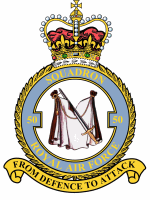No. 50 Squadron RAF
| No. 50 Squadron RAF | |
|---|---|

Official squadron crest
|
|
| Active | 15 May 1916 – 13 June 1919 3 May 1937 – 31 January 1951 15 August 1952 – 1 October 1959 1 August 1961 – 31 March 1984 |
| Country |
|
| Branch |
|
| Motto(s) |
Latin: Sic fidem servamus ("Thus we keep faith") Squadron crest shows "From Defence to Attack" |
| Battle honours | Home Defence, 1916-18*: Channel & North Sea, 1939-43*: Norway 1940: Baltic, Invasion Ports, 1940: 1940-43: France & Low Countries, 1940: Biscay Ports, 1940-44: German Ports, 1940-45*: Ruhr, 1940-45*: Berlin, 1940-44*: Fortress Europe, 1940-44*: Normandy, 1944*: France & Germany, 1944-45*: Walcheren: Rhine: Honours marked with an asterisk are those emblazoned on the Squadron Standard |
| Insignia | |
| Squadron badge heraldry | A sword in bend severing a mantle palewise. This unit formed at Dover and adopted a mantle being severed by a sword to show its connection with that town, the arms of which include St. Martin and the beggar with whom he divided his cloak. The mantle is also indicative of the protection given to this country by the Royal Air Force. |
| Squadron codes |
QX Dec 1938 - Sep 1939 VN Sep 1939 - Jan 1951 |
No. 50 Squadron was a squadron of the Royal Air Force. It was formed during the First World War as a home defence fighter squadron, and operated as a bomber squadron during the Second World War and the Cold War. It disbanded for the last time in 1984.
No. 50 Squadron of the Royal Flying Corps founded at Dover on 15 May 1916. It was equipped with a mixture of aircraft, including Royal Aircraft Factory B.E.2s and Royal Aircraft Factory B.E.12s in the home defence role, having flights based at various airfields around Kent. It flew its first combat mission in August 1916, when its aircraft helped to repel a German Zeppelin. On 7 July 1917 a 50 Squadron Armstrong Whitworth F.K.8 shot down a German Gotha bomber off the North Foreland of Kent. In February 1918, it discarded its miscellany of aircraft to standardise on the more capable Sopwith Camel fighter, continuing to defend Kent. By October 1918, it was operating its Camels as night fighters. It was during this period that the squadron started using the running dogs device on squadron aircraft, a tradition that continued until 1984. The device arose from the radio call sign Dingo that the squadron was allocated as part of the Home Defence network. It disbanded on 13 June 1919. The last CO of the squadron before it disbanded was Major Arthur Harris later to become Air Officer Commanding-in-Chief of RAF Bomber Command during the Second World War.
...
Wikipedia
